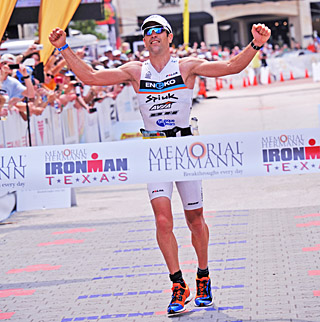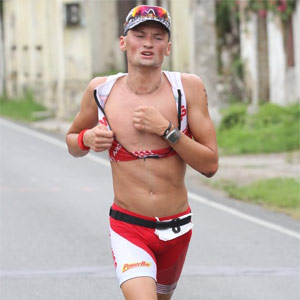Triathlon’s Doctor Phil reflects
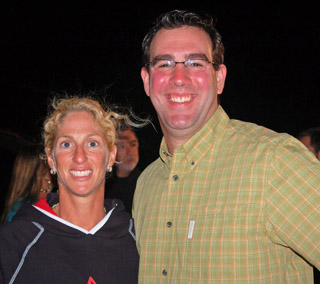
Phillip Skiba is now 36 years old and is a bearlike fellow, roughly 6-feet and 210 pounds, whose first athletic love was surfing and skateboarding on the Jersey Shore where he served as a lifeguard. In team sports, he played intramural volleyball in high school and played some in college until he was sidelined by a knee injury. While pursuing his masters in molecular genetics at the University of Medicine and Dentistry of New Jersey, he got the shock of his life in 1997 when he was diagnosed with testicular cancer. Thanks to what he described as “an impossible stroke of luck,” the tumor essentially disappeared and Skiba got serious about his life and went after a medical degree. With his new lease on life, he became determined to become the best athlete he could be and evolved into a runner, cyclist and a Clydesdale triathlete who loved playing endurance sports, making up for his inefficient power-to-weight ratio with a big heart and an indefatigable hunger to devour all the information on sports medicine, exercise physiology and training he could find.
As he started work as a doctor, word of his expertise in exercise physiology got out among fellow members of his triathlon club and he started answering questions about training and things snowballed. In the next few years he wrote two books on triathlon training, created some training software, did some lecturing and ultimately decided he would not pursue the usual medical practice. Now he serves as program director for Sport and Exercise Medicine at the University of Exeter in the United Kingdom. There he also is a member of the Jones Laboratory, a leading research center in VO2 kinetics. He dedicates half his time to scientific and medical pursuits, and half to coaching two middle of the pack athletes, four age group champions and three elites — two of whom are world champions.
When searching for a reason why Skiba’s coaching attracted champions like Zeiger and Catriona Morrison as well as age group triathlete Melissa Merson, the obvious reason is that the two champions with graduate degrees in science and cancer survivor Merson all found a kindred spirit and a welcome intelligence.
Slowtwitch: Did you have any sports heroes growing up?
Philip Skiba: My sports heroes were volleyball legends Karch Kiraly and Sinjin Smith. I'd record their tournaments and replay them over and over. I was also a big Lakers fan back in the glory days: Kareem, Magic, AC Green, and James Worthy were my patron saints.
ST: What other persons did you look up to – and why?
Phil: My great-granddad (who lived with me until I was 10), and my dad Bill were both volunteer firefighters, and I went to fire school and followed in their footsteps. I was only inside a real burning building once. It was hot as hell, I was wearing 50 pounds of gear, and I couldn't see two feet in front of my face. I did the job I was supposed to do (searched the building), but by the time I came out, I had developed a real respect for the men and women who were on the job every day. I seriously considered a career as a professional firefighter for a while, but the urge for higher education was stronger, so that is what I did.
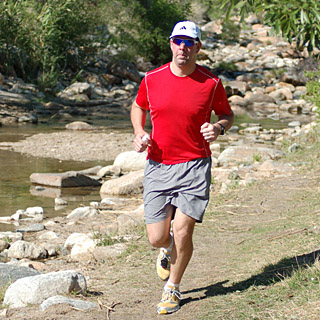
ST: Who inspired you growing up?
Phil: My granddad was a surgical nurse in the South Pacific during World War II. At one point he worked across the table from the Mayos of the Mayo Clinic. He taught me the medicinal value of a silly sense of humor. For instance, as a kid I was constantly getting splinters in my feet. He'd fish them out with one of his vintage WWII-era forceps, and every time I said "Ouch!" he'd say, "Really? I didn't feel a thing!" Or you might have a stomach bug and say, "I'm sick." and he would say, "Oh really? I'm Grandpa. Nice to meet you." He'd get the laugh out of you, and you always felt a little better. His attitude from the war was that if no one was about to die, you could afford to laugh and lighten the mood. My dad was of the same ilk. My dad's advice of, "The only time you are allowed to get excited is when the fire is at your house" has always resonated with me. I tell that line to every junior doctor that has ever worked under me.
ST: Where did you go to college as an undergraduate and what did you study?
Phil: Siena College in Loudonville, New York. I studied biology, but had real aptitude for molecular biology and physics.
ST: Where did you to go graduate school and what were you studying?
Phil: The University of Medicine and Dentistry of New Jersey. I was working in molecular genetics. We were trying to understand how genes were expressed in the parasites that caused certain types of diseases (malaria, sleeping sickness.) I left with a master's and went to medical school.
ST: What symptoms led you to go to the doctor in 1997 when you were diagnosed with testicular cancer?
Phil: I was out surfing during the summer of 1997 and developed pretty serious pain, which I really couldn't ignore and then went to the doctor. He took one look at me and sent me to a specialist in the same office, and I had some scans done. The next thing I knew, I was being told I had testicular cancer and that from the size of the tumor, I could probably expect to find it in my lungs and brain. It turned my world completely upside down.
ST: What changes in your life did you face with the treatment?
Phil: At 23, you are still prone to the invincibility complex that comes with youth. So, when you suddenly find yourself faced with your own mortality, it is like a punch in the nose. I can remember thinking, "Cancer? I swam two miles in the ocean last weekend, and then got my ass kicked on a five-mile run with a friend who plays professional soccer. Are you out of your mind?!"
ST: What was the biggest impact?
Phil: The changes were mostly mental and emotional. For instance, my dad is this huge bear of a man who drove a fire truck [and is a dentist and an Clinical Professor at the NYU Dental School.] It is a hell of a thing to see a guy like that cry because he is worried about you. So, I decided that I was going to be the tough one, and that I'd let that rub off on everyone else. That worked, except that the process took a different sort of toll on me. Afterwards, everyone else is fine, and you are an emotional wreck because you kept all of that under wraps. It still informs the decisions I make as a doctor. For instance, one of the reasons I can't be an oncologist is that I have a very hard time surrendering to cancer, even when it might be in the best interests of my patient. When doing my oncology rotations as a student, my attitude with the patients was, "I know you are really sick, and that there might be nothing left to do, but we are going down swinging." I was belligerent in the face of death. However, true strength knows when it is time to be even braver and lay arms down. This said, my never-say-die attitude works very well in sports medicine, which is my specialty, and in coaching.
ST: When you sat down and took stock of your life and your goals after cancer, what did you think was in your future?
Phil: I only had one really major regret in my life, which was that I felt that I had never lived up to my potential. I was a reasonably smart guy, but teachers and professors throughout my life accused me of coasting, which was true, to a point. It wasn't that I really coasted, but rather that I applied effort to the things I loved (science, writing) and blew off the things I didn't. I decided that if I lived, I was actually going to apply myself to everything and see where life took me. Medicine seemed a natural direction given what I was experiencing. I correctly believed that having been a patient would give me a unique and rare perspective as a doctor.
ST: What did the surgery find and what did it do to halt the cancer?
Phil: When they went in, they found that the tumor had eroded into a blood vessel. The pain I'd felt was the tumor bleeding out within itself, which essentially choked it to death. By the time they got in there during my surgery, most of the cancer cells were dead and it was very hard to even decide what cell type the tumor was. Also, all of my lymph nodes were cancer-free. My doctors decided there was no need for radiation or chemotherapy. My tests were otherwise good, and they would monitor me for a time. In other words, I was the luckiest guy in the world.
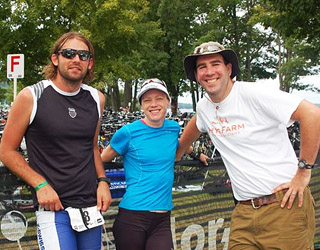
ST: Who got you involved in triathlon?
Phil: Jim Carothers was one of my medical school classmates. He had raced as a professional cyclist, and then got involved as a pro triathlete. He taught me the basics of training. Another of my classmates was Jeff Rasch, who was a pro cyclist for several years. He introduced me to things like heart rate monitors. The most influential person was my physiology professor, Bill Sexton. He explained to me how little athletes understood about training, and pointed me towards Astrand's Textbook of Work Physiology.. From there, everything snowballed. As my own training improved through the use of science, I wanted to learn more and more. Moreover, as I learned that I was not cut out to be a great endurance athlete, I became eager to experiment on someone who was.
ST: How did your body respond to training?
Phil: I took about 10 minutes off my 5k time over a period of several months. However, the basic facts of my physiology are such that I am gifted in terms of strength, speed and anaerobic capacity. Training improved my endurance, but I have never run any better than 22 minutes for 5k. I love the process, but I understand my limitations. I had a goal to complete an Ironman and in 2002 I went to Lake Placid which was, in a word, harsh. My training was really suboptimal. I was working 100 hour weeks as a third year medical student, and squeezing training in around that.8 hours a week if I was lucky. Between the thunderstorms, a basic lack of training, and detonating on the bike leg after trying to drop someone who was drafting behind me, I finished just before midnight. I figured if cancer didn't kill me, Ironman wouldn't either.
ST: How did you start advising athletes about training?
Phil: It was all very accidental. I was fascinated by exercise physiology. I had digested a huge amount of the science of training in an effort to optimize my own performance, and word got out among my patients and training partners. People in my tri club started asking for my opinions. Then people started turning up in my medical office asking for training tips. I'd write little schedules, suggest workouts, and then some of them started winning races. This began to spread by word of mouth.
ST: Why was your advice working for them?
Phil: The athletes who were willing to do the work, day in and day out, week in and week out, saw the benefits. I also worked very hard at busting myths. No, you don't need to do endless squats in the weight room. No, you don't need to spend time trying to "pedal circles." No, you cannot tool around easy all the time and then expect to race hard.
ST: When did you graduate from medical school and what was your initial specialty?
Phil: I graduated from Kirksville College of Osteopathic Medicine in Missouri in 2003. [From Wikipedia “Like M.D.s, osteopathic physicians complete 4 years of medical school and can choose to practice in any specialty of medicine. However, osteopathic physicians receive an additional 300 – 500 hours in the study of hands-on manual medicine and the body's musculoskeletal system. An osteopathic physician will often use a treatment method called osteopathic manipulative treatment (also called OMT or manipulation) — a hands-on approach to make sure that the body is moving freely.”]
My internship was internal medicine, and then I spent a year at Georgetown University training in Physical Medicine and Rehabilitation. I wasn't getting enough sports and musculoskeletal medicine experience, however, so I finished up in Family Medicine and then did my fellowship training in Sports Medicine. The Family Medicine experience is really important, because most sports medical problems are not orthopedic!
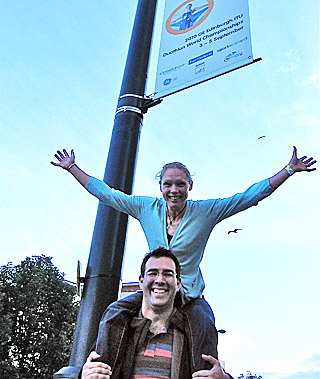
ST: What happened in the decade after you were diagnosed with testicular cancer and the time late in 2007 when you devised a training methodology and software?
Phil: I did a huge amount of reading and research, which led to my first book, Scientific Training for Triathletes. I took the broad points of what I learned, and wrote them down in concise form so that triathletes would have a single source that addressed the main points of training in language they could easily understand. What is VO2 max? What is LT [lactate threshold]? What do they actually mean in terms of your training? The book is a starting point, not an ending point, just as one scientific paper always leads to another. It allows you to follow lines of evidence that suggest particular ways to train. My goal was to give people the tools to develop a good training program on their own. Then people wanted to know how I trained my athletes. That brought about my second book, The Triathlete’s Guide To Training With Power. I also did some lecturing for USAT, and put on continuing education courses for coaches.
ST: What measurements (heart rate / power meters / lactate / perceived exertion) did you use to develop your methods of training?
Phil: I worked with all of the above at some point, but by far the best and easiest way to work is with power and pace, because they are objective. Human physiology "understands" training in terms of work rate. It isn't about how far, or how fast, but the combination of how much you did and how fast you did it (duration x intensity). Also, the intensity affects fitness nonlinearly. What that means is that training twice as hard doesn't provide just twice as much bang for your buck, but many times as much. Likewise, performance is best understood in the same terms. It's very nice if you can run a 10k, but there is a huge difference between running it in 60 minutes and running it in 30.
That said, there are a lot of coaches and athletes who don't like doing things in this very measured way, because it makes them accountable. Performance becomes quantifiable, which means everyone suddenly knows if your program really works or not. Either your lap splits come down or they don't. You cannot hide from the clock. If an athlete is not improving throughout their training, a coach should have to answer for that. The time to find out a training program isn't working is not on race day.
ST: You have several age group clients who have experienced great improvements. But two of your triathletes have been great world champions – Joanna Zeiger and Catriona Morrison, both of whom had considerable success before they came to you. Why did they come to you?
Phil: Joanna and Cat are similar in terms of raw talent, but required very different approaches because they have certain differences of physiology. As you point out, both are scientists [Zeiger has a PhD in genetic epidemiology from Johns Hopkins and Morrison has a masters in Earth and Atmospheric Sciences from Alberta University in Edmonton, Canada] and they were willing to apply a rational thought process to their training and you can see the results of that. Joanna was always a great athlete, but her greatest successes came after we rationally evaluated her training and performances, and then radically changed her approach. What she required was a limitation of volume, and race-specific intensity. Sure, she had a couple of high volume weeks, but she was doing far less training than she usually would have. Her performances then became highly consistent. In 2008, she won almost every half-Ironman she entered, and then set a world record in Clearwater.
In contrast, Cat was already a world champion duathlete when she came to me looking for success in triathlon. To optimally respond, Cat needs a combination of both volume and intensity, often in the same training cycle. For the past two seasons, she has won almost everything she has entered, and has had some really inspirational performances, including the fastest ever female Ironman-distance debut (8:47 at Roth 2009), and her win in Lanzarote 2010 after a 40-minute mechanical.
ST: How does being a doctor help your coaching?
Phil: To take the doctor angle a little bit further, I understand that very tiny signs and symptoms and foretell obnoxious things. My athletes know to bring even seemingly inconsequential things to me. If you can nip brewing injuries or overreaching in the bud, the athlete avoids real problems. Maybe you end up with 48 hours of recovery training, but this is inconsequential in the face of something more serious like a hamstring tear.
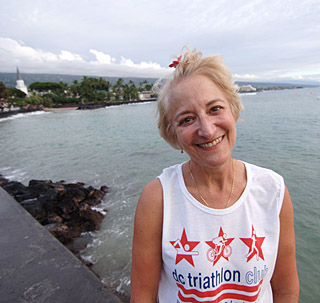
ST: How much debate do you have with two well-educated scientists/athletes?
Phil: I try very hard to understand how my athletes think, what they think, and why they think that way. I make it clear that I respect their opinions, even if we have different ideas about the best way forward. When I give advice, I provide a clear explanation and go into as much depth as they like, to the point that I forward scientific papers with things highlighted and underlined in order to help engender confidence in the program. (By the same token, JZ would often send papers back my way, pointing out different things and Cat will do the same.) We have a solid, defensible rationale for every bit of our program.
My athletes know that I want them to question me. I recently had to make a pretty serious change to Cat's bike training, and when she questioned it, I explained it to her in excruciating physiological detail. Her response was, "Well, I still don't like the idea but I believe you now, so we'll do it your way." As a result, we solved the issue and she had a great race at IM-Texas (1st place, sub-9 hours].
ST: What was the key to guiding Joanna Zeiger to her world championship and great career performances in 2008 after years of injuries?
Phil: There are a lot of specifics with respect to her physiology in particular, but let me share the stuff that applies to all athletes: Don't empty the tank in training. That means you stop the track workout before failure, and you stop the long bike ride before you can't maintain power and start soft-pedaling. For Joanna, as we approached Clearwater in 2008 and her physiology was peaking, she would say to me, "Phil, there is another gear there now. I can feel it." To which I would say, "Great. Don't use it." During the race, when she came out of T2 with the pack, I took one look at her competitors, and hollered "Go now!" They didn't have a prayer. I think she could have outrun anyone that day.
ST: And how did you help Catriona Morrison to her current high level of recent success?
Phil: For Cat, you can see the benefits of this in a few places. For instance, in Lanzarote last year, she was 40 minutes down after breaking her chain. She never panicked. She sat under a tree, hydrated, had the bike fixed, and rode it in at a totally reasonable power. She then ran the marathon of her life, taking the lead and the win with just 1k to go. That reserve was there because she didn't spend it gratuitously in training. Same thing at 2010 Duathlon Worlds [at Edinburgh, where she got off the bike even with Sandra Levenez of France and outran her 17:14 to 17:31]. We had simulated that bike course in training for months, but we never smashed Cat to pieces. On race day, she just rode away from them. Afterwards, I asked her how she felt. "I could have gone harder," she said, "But why? I already had the lead I needed." This comment speaks to the heart of my training philosophy. Don't be greedy: good enough is good enough. There are no prizes for finishing 10 minutes ahead versus 9, and that effort in pursuit of an extra minute for its own sake can have HUGE repercussions in terms of recovery, injury, or illness.
ST: Tell me what you brought to the table while coaching fellow cancer survivor Melissa Merson. What are the most important things you advised her to do as a coach and medical expert?
Phil: I feel a special duty to the cancer community, because of my history. Because of Melissa's particular situation, we knew she would only get one shot at Kona. For us, it was not as much about training to the numbers as it was bringing the mindset of cancer survivorship to bear against Ironman.
ST: What is the mindset of cancer survivorship?
Phil: I told Melissa that all of those people toeing the line in Kona think they are about to walk into hell, and they are right. However, cancer survivors bring a unique advantage. We have been someplace worse, mentally and physically. Moreover, people like Melissa have endured fifty times what I have: Radiation burns. Crippling nausea, weakness and deconditioning. IV bags full of chemicals so toxic that they basically call a HazMat incident if a drop gets on the floor rather than in a vein. The goal of survivorship in this context is not forgetting that it happened, but revisiting and sharpening those feelings. The pain you lived through becomes the measuring stick by which you judge every other hardship. The road to Hawi changes from, "It is a hundred degrees and this hill goes on for miles…" to "I'm going to make it to the top because I know how much that surgery hurt, and this is nothing in comparison." The 11 PM march on Alii Drive goes from, "I cannot take another step," to "I'm getting to that damn finish line before midnight in honor of every person dead and gone who would have sold their soul to feel the hell I'm going through tonight." When you make it personal in that way, it is much more difficult to fail. It gives you a supreme level of focus. It gives you the ability to go to a very dark place inside yourself, wrestle with your own weakness, and triumph over your own frailties.


